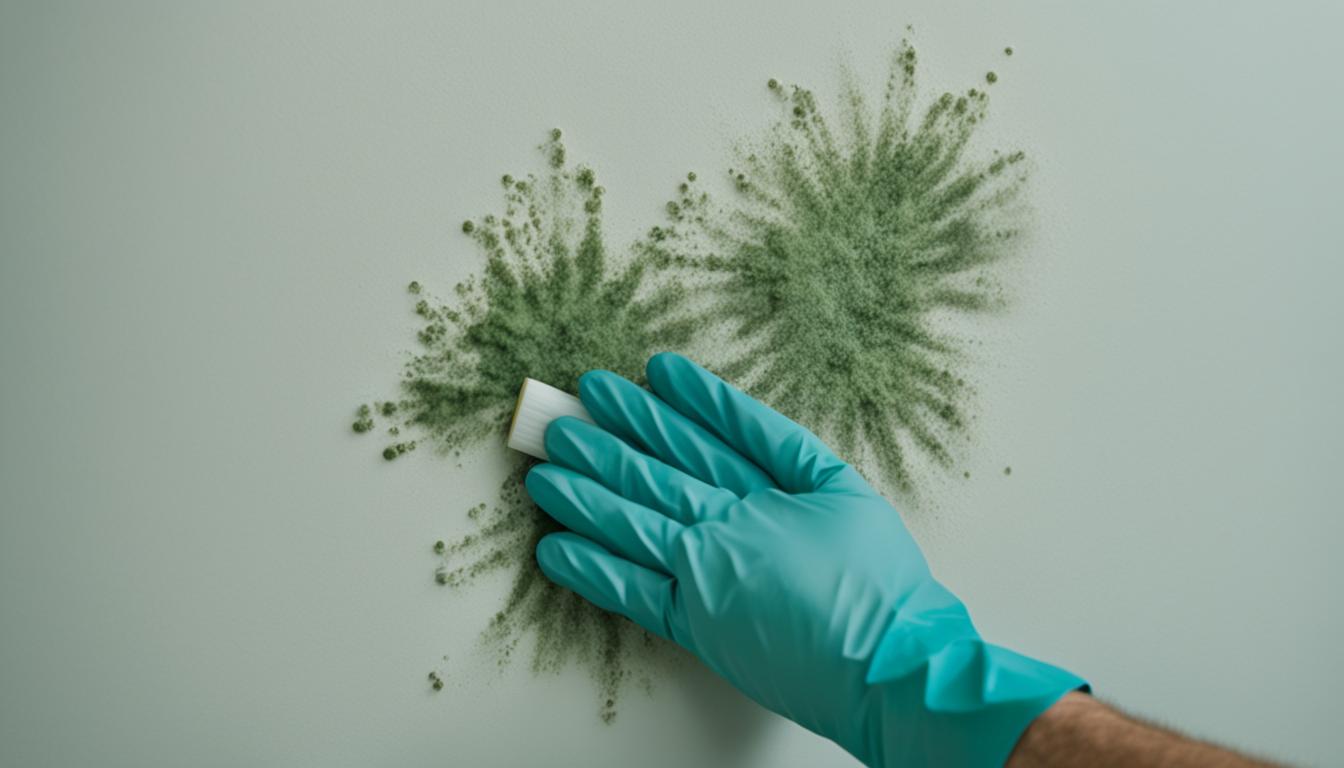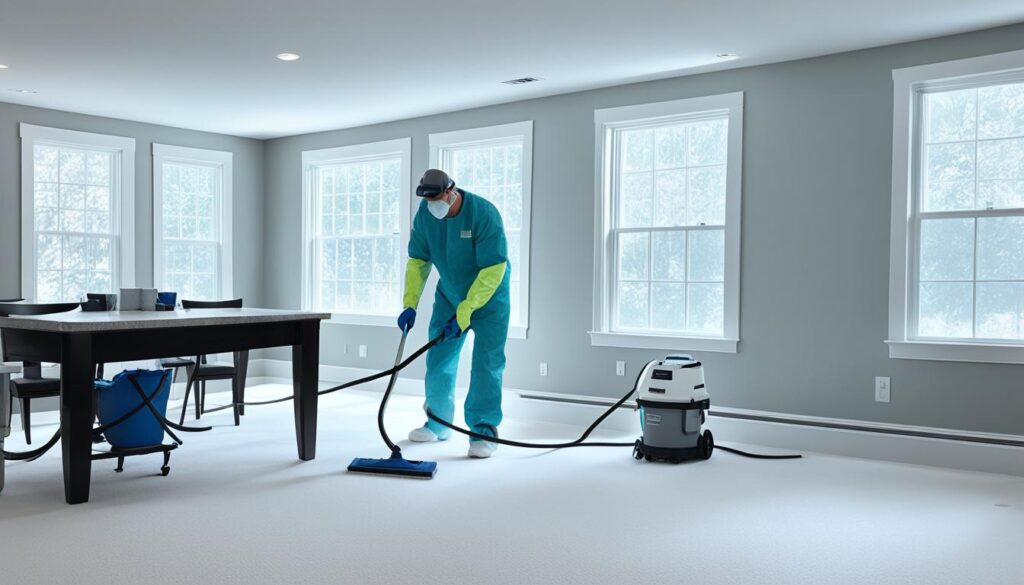
Mold Remediation: Effective Solutions for Homes
Welcome to our comprehensive guide on mold remediation! In this article, we will delve into the importance of mold remediation and how it can effectively tackle mold issues in homes. Are you ready to discover the methods and strategies that can ensure a healthier living environment for you and your family?
Key Takeaways:
- Mold remediation is crucial to maintain a healthy living environment in homes.
- Understanding the dangers of mold is essential for effective remediation.
- Early detection is key to preventing further mold growth and risks to health.
- Professional mold remediation services can provide thorough and lasting results.
- Take control of your home’s mold issues for a safer and healthier living space.
Understanding Mold and Its Dangers
Before diving into the remediation process, it’s crucial to understand mold and the potential dangers it poses to our health and homes.
In this section, we will delve into the different types of mold, their causes, and the risks associated with prolonged exposure. It is important to have a comprehensive understanding of mold to take effective remediation measures.
Mold is a type of fungus that thrives in warm and moist environments. It can be found both indoors and outdoors, and it reproduces by releasing spores into the air. When these spores land on surfaces with the right conditions, such as excess moisture, they can grow and multiply.
“Mold is a type of fungus that thrives in warm and moist environments.”
There are many different types of mold, including black mold (Stachybotrys chartarum), green mold (Aspergillus), and white mold (Penicillium). Each type can have varying effects on human health.
The Dangers of Mold Exposure
Prolonged exposure to mold can have detrimental effects on our health. Mold spores can trigger allergic reactions, such as sneezing, coughing, and skin irritations, in individuals who are sensitive or allergic to mold.
In addition to allergic reactions, mold exposure can also lead to respiratory issues, especially in individuals with asthma or other respiratory conditions. It can cause symptoms such as wheezing, shortness of breath, and chest tightness.
Moreover, certain types of mold, such as black mold, produce mycotoxins. These toxic substances can be harmful when inhaled or ingested, causing more severe health problems. Long-term exposure to mycotoxins has been linked to respiratory illnesses, neurological issues, and even organ damage.
“Prolonged exposure to mold can have detrimental effects on our health.”
It’s important to note that the severity of mold-related health issues can vary depending on factors such as the individual’s sensitivity, the type of mold, and the duration and intensity of exposure. However, regardless of the specific mold type, it’s crucial to address any mold growth in our homes promptly and thoroughly.
Early Detection and Effective Remediation
Early detection of mold growth is key to preventing its spread and minimizing health risks. Regularly inspecting your home for signs of mold, such as musty odors, visible discoloration, or water damage, can help you identify and address mold issues early on.
When it comes to mold remediation, it’s essential to take a comprehensive and systematic approach. This involves identifying the source and extent of mold growth, addressing any underlying moisture issues, and using appropriate techniques to safely remove and clean affected areas.
Professionals equipped with the necessary knowledge and tools can provide effective mold remediation services, ensuring that the problem is eliminated at its root. Additionally, they can help implement preventive measures to reduce the chances of future mold growth.

By understanding the dangers of mold and taking proactive measures, we can protect ourselves and our homes from the detrimental effects of mold exposure. In the next section, we will explore effective mold remediation strategies, guiding you through the step-by-step process of restoring a mold-free living environment.
Effective Mold Remediation Strategies
Now that we have a deeper understanding of mold, it’s time to explore the proven strategies for effective mold remediation. Mold growth in homes can pose serious health risks and cause structural damage if left unchecked. By following these step-by-step processes, you’ll be able to eliminate mold and create a healthier living environment for you and your family.
- Assessing the extent of mold growth: Before starting the remediation process, it’s crucial to determine the severity of mold contamination. Conduct a thorough inspection of the affected areas, including hidden spaces such as behind walls and under carpets. This assessment will help you develop a targeted plan for mold removal.
- Implementing containment measures: To prevent the spread of mold spores during remediation, it’s essential to establish containment barriers. Use plastic sheets to seal off the affected area and install air scrubbers or negative air machines to filter out mold particles.
- Removal of mold-infested materials: Once containment measures are in place, remove all mold-infested materials from the affected area. This may include drywall, carpeting, insulation, and furniture. Proper disposal techniques should be followed to prevent cross-contamination.
- Cleaning and disinfection: Thoroughly clean all surfaces in the affected area using appropriate mold disinfectants. This step helps eliminate any remaining mold spores and prevents future growth.
- Drying and dehumidification: Mold thrives in damp environments, so it’s crucial to dry the affected area completely. Use dehumidifiers and fans to remove excess moisture and ensure a dry, inhospitable environment for mold.
- Preventive measures: To prevent mold from recurring, it’s important to address the underlying moisture issues. Identify and fix the source of moisture, whether it’s a leaky pipe or improper ventilation. Implement preventive measures such as installing moisture barriers, improving insulation, and using mold-resistant materials.
By following these effective mold remediation strategies, you can effectively eliminate mold from your home and create a healthier living environment. Remember, for professional mold remediation services, contact Fix Mold Miami at 305-465-6653.

Key Takeaways:
– Assess the extent of mold growth to develop a targeted remediation plan.
– Establish containment measures to prevent the spread of mold spores.
– Remove all mold-infested materials from the affected area.
– Clean and disinfect surfaces using specialized mold disinfectants.
– Dry the affected area completely to prevent future mold growth.
– Address underlying moisture issues and implement preventive measures.
| Advantages | Disadvantages |
|---|---|
| – Thorough elimination of mold | – Requires professional expertise |
| – Creates a healthier living environment | – Can be time-consuming |
| – Prevents structural damage | – Potential disruption to daily life |
| – Reduces health risks associated with mold exposure | – Cost of remediation |
Conclusion
In conclusion, mold remediation is an essential step in safeguarding your home and maintaining a healthy living environment for you and your loved ones. By understanding the dangers associated with mold and implementing effective strategies, you can effectively eliminate mold growth and prevent its recurrence.
It is crucial to address mold issues promptly and thoroughly to minimize potential health risks. Mold can trigger allergies, respiratory problems, and other health complications, especially in individuals with weakened immune systems. Therefore, taking proactive measures to eradicate mold is of utmost importance.
To ensure comprehensive mold assessments, preventive measures, and professional remediation services, we recommend contacting Fix Mold Miami at 305-465-6653. Their team of experts specializes in providing reliable solutions tailored to your specific needs, helping you regain control over your home’s mold issues and create a safer and healthier living space.




